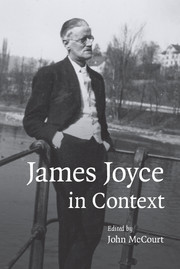Book contents
- Frontmatter
- Contents
- Notes on contributors
- Preface
- List of abbreviations
- PART I LIFE AND WORKS
- PART II THEORY AND CRITICAL RECEPTION
- PART III HISTORICAL AND CULTURAL CONTEXTS
- 14 Being in Joyce's world
- 15 Dublin
- 16 Nineteenth-century lyric nationalism
- 17 The Irish Revival
- 18 The English literary tradition
- 19 Paris
- 20 Trieste
- 21 Greek and Roman themes
- 22 Medicine
- 23 Modernisms
- 24 Music
- 25 Irish and European politics: nationalism, socialism, empire
- 26 Newspapers and popular culture
- 27 Language and languages
- 28 Philosophy
- 29 Religion
- 30 Science
- 31 Cinema
- 32 Sex
- Further reading
- Index
30 - Science
Published online by Cambridge University Press: 14 July 2009
- Frontmatter
- Contents
- Notes on contributors
- Preface
- List of abbreviations
- PART I LIFE AND WORKS
- PART II THEORY AND CRITICAL RECEPTION
- PART III HISTORICAL AND CULTURAL CONTEXTS
- 14 Being in Joyce's world
- 15 Dublin
- 16 Nineteenth-century lyric nationalism
- 17 The Irish Revival
- 18 The English literary tradition
- 19 Paris
- 20 Trieste
- 21 Greek and Roman themes
- 22 Medicine
- 23 Modernisms
- 24 Music
- 25 Irish and European politics: nationalism, socialism, empire
- 26 Newspapers and popular culture
- 27 Language and languages
- 28 Philosophy
- 29 Religion
- 30 Science
- 31 Cinema
- 32 Sex
- Further reading
- Index
Summary
The abnihilisation of the etym by the grisning of the grosning of the grinder of the grunder of the first lord of Hurtreford expolodotonates through Parsuralia …
(FW 353.22–4)In April 1919, the Nobel laureate nuclear physicist Ernest Rutherford sent papers to the Philosophical Magazine showing that he had completed the quest for the current Holy Grail of nuclear physics: he had been the first to disintegrate (or ‘split’) an atom and thus document an artificial transmutation of one element into another. Joyce, who likewise was splitting and reforming the ‘etyms’ of language in Finnegans Wake, commemorated Rutherford's achievement in Hurtreford's expolodotonation, self-consciously raising the question of his novel's relationship to the physics that was bringing into ‘view’ a subatomic world. The period during which Joyce published his major works – from the first Dubliners story in the Irish Homestead in 1904 to Finnegans Wake in 1939 – saw monumental changes in the way the physical sciences understood the nature of matter and energy. Joyce and his contemporaries witnessed several ‘paradigm shifts’, as Thomas Kuhn would call them. The discovery of x-rays by Röntgen in 1895, of radioactivity by Becquerel a few months later and of electrons in 1897 by J. J. Thomson helped set chemistry and physics on a path toward knowledge of the subatomic world. In 1901 and 1902, Soddy and Rutherford explained the mechanism of radioactivity as the disintegration of radioactive elements, and Rutherford soon discovered the proton.
- Type
- Chapter
- Information
- James Joyce in Context , pp. 343 - 354Publisher: Cambridge University PressPrint publication year: 2009
- 1
- Cited by



